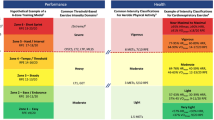Abstract
This paper applies pattern recognition and conventional analysis methods to visually and quantitatively study the undergraduate students’ fitness situations in the sampling region of northern Jiangsu of China. We first use the conventional analysis to examine whether the students’ fitness is promoted based on current standards and requirements for sports training by analyzing the changing trends of higher-grades students’ fitness. We also compare the fitness of the same-grade male and females. Secondly, the fitness data are collected under the same standards and operations, so the test data (at various levels) of the same grade should be easy to be separated in the low-dimensional space if both training standards and fitness test operations are effective. We mainly apply the pattern recognition technique to verify this hypothesis through visualizing embedded fitness data to visually perceive the intra- and inter-level distributions. The analysis results illustrate that the higher-grades students’ fitness has the uptrend and the fitness of males is better than that of the same grade females. The visualization on the embeddings of fitness data confirmed the hypothesis and also demonstrated the validity of visualization technique in analyzing the fitness data in sports sciences.



Similar content being viewed by others
References
China Sports and Physical Education Committee and the National Education Department (2002) Student physical health standards. People’s Education Press, Beijing
Kilpatrick M, Hebert E, Bartholomew J (2005) College students’ motivation for physical activity: differentiating men’s and women’s motives for sport participation and exercise. J Am Coll Health 54(2):87–94
Chomitz VR, Slining MM, McGowan RJ, Mitchell SE, Dawson GF, Hacker KA (2009) Is there a relationship between physical fitness and academic achievement? Positive results from public school children in the northeastern United States. J Sch Health 79(1):30–37
Grissom JB (2005) Physical fitness and academic achievement. J Exerc Physiol Online 8(1):12–25
Rodenroth K (2010) A study of the relationship between physical fitness and academic performance. PhD thesis, The Faculty of the School of Education, Liberty University
Chen YP (2010) Survey and study on the physical quality of students of Qingdao University of Science and Technology. Asian Soc Sci 6(7):142–145
HHS/CDC Healthy People (2010) Physical activity in children and adolescents, vol. 2
Häkkinen A, Rinne M, Vasankari T, Santtila M, Häkkinen K, Kyröläinen H (2010) Association of physical fitness with health-related quality of life in Finnish young men. Health Qual Life Outcomes 29:8–15
Calea L, Harrisa J, Chen MH (2012) Monitoring health, activity and fitness in physical education: its current and future state of health. Sport Educ Soc. doi:10.1080/13573322.2012.681298
Calea L, Harris J (2006) School-based physical activity interventions: effectiveness, trends, issues, implications and recommendations for practice. Sport Educ Soc 11(4):401–420
Orunaboka TT, Ogulu CB (2013) Analysis of physical fitness of female undergraduate students of education management, University of Port Harcourt. Acad Res Int 1(1):199–207
Deng XF, Huang Y, Deng MY, Qu SH (2003) A comparative study of fitness test batteries between school-based physical education programs in the USA and the People’s Republic of China. Int Sports Stud 25(1):5–22
Jain A, Duin R, Mao J (2000) Statistical pattern recognition: a review. IEEE Trans Pattern Anal Mach Intell 221:4–37
Huber C, Göpfert B, Kugler PF, von Tscharner V (2010) The effect of sprint and endurance training on electromyogram signal analysis by wavelets. J Strength Cond Res 24(6):1527–1536
Fisher RA (1936) The use of multiple measurements in taxonomic problems. Ann Eugen 7:179–188
Lang S (1987) Linear algebra, 3rd edn. Springer-Verlag, New York
Zhang Z, Chow TWS, Zhao MB (2013) Trace ratio optimization based semi-supervised multimodal nonlinear dimensionality reduction for marginal manifold visualization. IEEE Trans Knowl Data Eng 25(5):1148–1161
Zhang Z, Chow TWS, Zhao MB (2013) M-Isomap: orthogonal constrained marginal Isomap for nonlinear dimensionality reduction. IEEE Trans Syst Man Cybern Part B Cybern 43(1):180–192
Conflict of interest
None.
Author information
Authors and Affiliations
Corresponding author
Rights and permissions
About this article
Cite this article
Shi, Q. Study on fitness tests of Chinese Northern Jiangsu undergraduate students by conventional and pattern recognition techniques. Sport Sci Health 9, 97–105 (2013). https://doi.org/10.1007/s11332-013-0150-0
Received:
Accepted:
Published:
Issue Date:
DOI: https://doi.org/10.1007/s11332-013-0150-0




